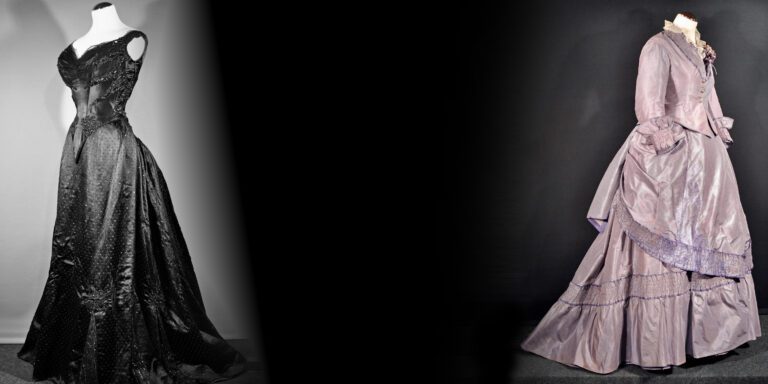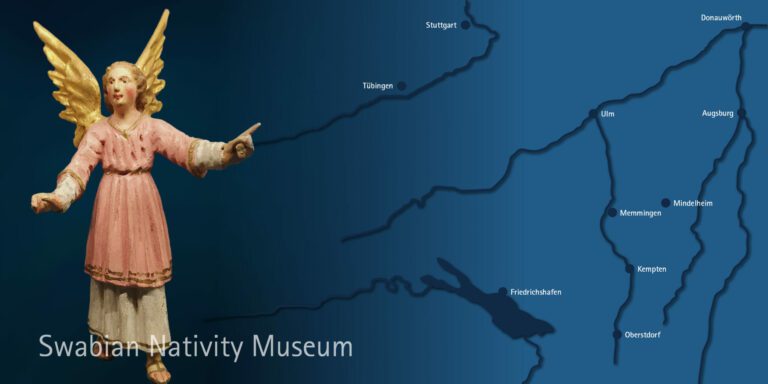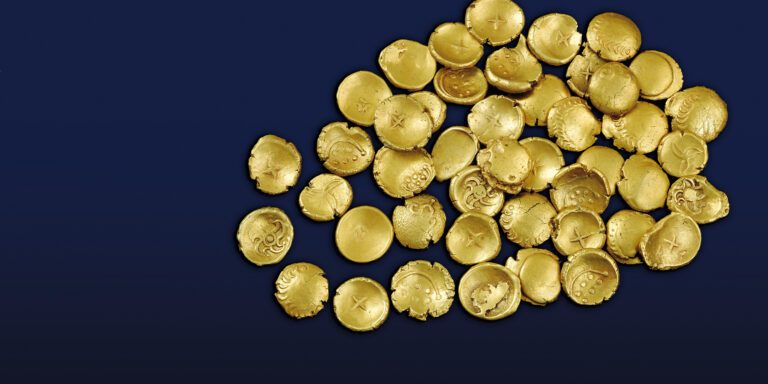There is currently no special exhibition on show, but we invite you to visit our standing exhibitions.
Archive
Some of our special exhibitions in the past …
Passions-Krippen und Österliches
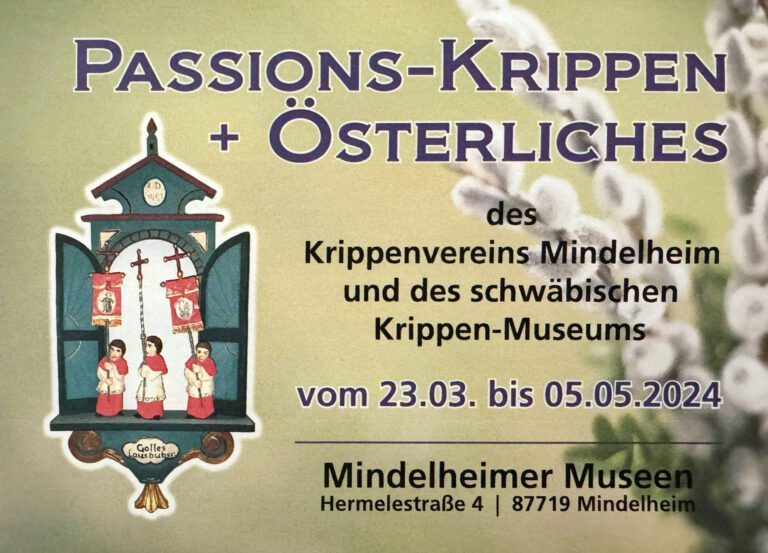
Ausstellung des Verbands Bayerischer Krippenfreunde in den "Museen im Colleg" vom 25. November bis 2. Februar 2024
Erfreuen sie sich an der Vielfalt von Krippen …
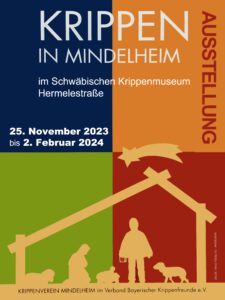
Cheap is too expensive. Fast Fashion and its consequences
The term „fast fashion“ describes a development in the fashion industry that emerged in the 1990s. Mass-produced clothing is put on the market at dumping prices and at very short intervals. While the luxury fashion houses present only two manageable collections a year in their haute couture fashion shows, the fast fashion brands offer thousands of new models online – every day. People are now even talking about “ultra fast fashion”. Characteristic of this „super fast fashion“ are, firstly, the low prices that tempt us to consume even more clothing even more often, and secondly, the incredibly short intervals between collections that constantly urge us to chase the latest fashion trend. In order to be versatile in terms of fashion, we buy even more clothes even more often. Many people submit to the dictates of the fashion chains and flirt with the idea of being a “fashion victim”. Fashionistas are permanently under massive pressure not to miss a trend.
More information in our flyer …
GIOVANNI GAMBASIN – Metamorphoses
The current works of the painter, photographer, self-taught artist and surrealist Giovanni Gambasin are extremely detailed cosmoses in miniature format, created using coloured pencils, ink and watercolours on paper. In the play of lines, of deliberately set contrasts of chiaroscuro and delicate colours, evocative organic-like shapes, designs and ornaments unfold in overwhelming density.
The artist constantly remains true to surrealism, to which he has devoted himself for decades, but in a completely new form. He begins his work without prerequisite or programme. Materials, paper and colours suffice. During the creative process, lines and forms take shape and progressively engender meanings, which gradually reveal themselves to the artist until his work is completed. It is left to the observer to enjoy discovering the references and meanings for himself.
Giovanni Gambasin has held exhibitions in numerous cities including Rome, Venice, Padua, Treviso, Milan and Asolo. He has also exhibited in Banja Luka, Bremen, Bellingen, Berlin and London, among other places. He has participated in more than 300 collective exhibitions and painting competitions. In 2021, he was awarded the art prize of the city of Canale Monterano di Roma and the University of Rome.
Black and White Photography Competition organised by the German Photography Association – DVF Landesverband Bavaria
Exhibition of 100 accepted photographs out of 478 submitted in the Mindelheim Museums/Museen im Colleg, Hermelestr. 4, Mindelheim
19 November 2022 to 29 January 2023
This year’s black-and-white photography competition, organised by the German Photography Association and hosted by the Fotoclub Mindelheim, has no thematic restrictions. Judging by our experience in past years, the photos presented in the Mindelheim museums will be truly masterful and will give evidence of the high proficiency of ambitious photographers.
Ever since the beginnings of photography in the 19th century, very sophisticated artistic developments have been taking place alongside the field of purely casual and utilitarian photography. This field of art is constantly advancing, finding new themes and expressive possibilities, aided as it is by the immense possibilities offered by modern image processing.
Because black-and-white photography is limited to the basic shades of black and white and thus produces images of greater concentration in comparison to colour photography, the works created are distinguished by their powerful intensity. This special exhibition therefore complements the exhibits held in the Mindelheim museums by presenting works of contemporary photographic art.
Special Exhibition “Up and away! Out of the Allgäu and around the world”
Johann Georg Grimm (1846-1887)
Special exhibition in the Museen im Colleg from 24 June 2022 to 16 October 2022
The Museum in Mindelheim is dedicating a unique exhibition to the art and the eventful life of Johann Georg Grimm, who began as a carpenter in Bühl am Alpsee, then studied painting at the Munich Academy in a period of great hardship, finally ending up in Brazil after a roundabout career. Emperor Pedro recognised Grimm’s outstanding talent and appointed him Professor at the Academy, where a circle of talented young artists gathered around him and he advanced to become one of Brazil’s greatest artists. In the manner of his great models of the Barbizon School, he passed on to his students his enthusiasm for working en plein air, a style of painting suffused with light. This light radiates from his works and illuminates even grey pencil sketches.
Grimm is regarded as the most important painter from the Allgäu region, and this exhibition is a fitting tribute to his significance following a long period of oblivion.
Tradition bis Moderne XII
The German Patchwork Guild presents the twelfth round of its juried competition “Tradition to Modern”. This competition for textile work in the form of quilts is held every three years and is characterised by the fact that it imposes very few rules. Free from strict specifications concerning theme, technique or size, members of the Patchwork Guild are invited to implement their own ideas and convey to the public the themes that are most important to them, thereby showcasing their technical abilities.
THREE GENERATIONS OF BÖHM – 100 years of world-class architecture
HILDA SANDTNER – THE ARTIST. EXHIBITION IN HONOUR OF HER 100TH BIRTHDAY
Hilda Sandtner enjoyed international fame as a textile artist. The special exhibitions of her works shown in many countries around the world gave her the opportunity to get to know faraway countries. She recorded her impressions of a country and its people in quick sketches. These formed the basis for her pastels, which she reinterpreted at home, usually on coloured paper.
Filznetzwerk „Ver“kleidung
The goal set by the Filznetzwerk (Felt Network Organisation) is to promote the production of handmade felt. The focus is on craftsmanship and the quality of the end product. Coverings (“Verkleidungen”) protect things and people from impact, environmental influences and prying eyes. The exhibition reveals the wide range of applications for handmade felt, ranging from delicate garments to all kinds of robust, resilient protective coverings.
TWO REASONS TO CELEBRATE
In 2019, nativity crib enthusiasts in Mindelheim had two reasons to celebrate. This special exhibition of historic nativity scenes from Mindelheim was created to mark the occasion of the anniversaries, 30 years of the Swabian Nativity Museum and 50 years of the Verband bayerischer Krippenfreunde.
Horst Haitzinger – Antiquity in political caricatures – MORE THAN JUST EUROPE.
Horst Haitzinger is well known to many newspaper readers for his accurate political caricatures. In over 60 years, he has created some 16,000 caricatures, including some watercolours. What is less well known is that he often made use of comparisons and references from Greek and Roman Antiquity. His work features not only buildings such as the Colosseum or the Parthenon in Athens, but also a wide variety of mythical figures from Europe, ranging from Sisyphus to the Trojan horse. Egyptians, the Stone Age and even scenes from Asterix are also to be found.


